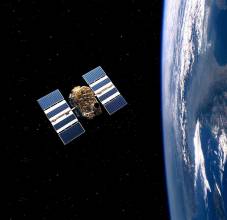At 25 years old, Global Positioning System Satellite Vehicle Number 27 completed its time in orbit on April 18, and the 2nd Space Operations Squadron (2 SOPS) said goodbye via final command after disposal operations were complete. SVN 27 was launched in 1992, meaning it lasted more than triple its design life of 7.5 years.
At 25 years old, Global Positioning System Satellite Vehicle Number 27 completed its time in orbit on April 18, and the 2nd Space Operations Squadron (2 SOPS) said goodbye via final command after disposal operations were complete. SVN 27 was launched in 1992, meaning it lasted more than triple its design life of 7.5 years.
“The most interesting thing about this process for me, was the ability to do some experimentation and advance training prior to the disposal,” said 1st Lt. Cameron Smith, 2 SOPS bus subsystem analyst. “Experimentation started in mid-March which consisted of advance training opportunities and vehicle component validation. This was very exciting and new to a lot of people in 2 SOPS.”
Smith explained that even though when launched SVN 27 was six times better than spec, it is now considered an “underperforming satellite” when compared to the rest of the constellation due to better clocks on the rest of the satellites. Therefore, a decision was made to remove SVN 27 from the GPS constellation to make room for satellites with increased capability.
Since GPS satellites do not carry the amount of fuel required for de-orbit maneuvers, they are instead pushed into a "graveyard" orbit, above the operational GPS orbit.
During disposal operations on the vehicle, the satellite is commanded into the safest, lowest energy state possible. This means all fuel has been depleted from the fuel tanks and the vehicle is placed in a spin-stabilized configuration.
Bus component degradations and navigational issues, among other reasons, are why SVN 27 was nominated for disposal. Fortunately for SVN 27, there were no major flaws throughout its life span.
“SVN 27 was disposed of because its navigation payload could no longer perform up to the GPS standards,” said 1st Lt. Shannon Sewell, 2 SOPS subsystem analysis chief. “In 1993, a year after it launched, it had a suspect component we never tested out until we disposed of it. The decoder wasn’t fully powered. Since it was a backup, we made a decision to leave it in the same configuration. However, this did not cause any major effects during its life span.”
In the last two years, 2SOPS has conducted six disposal operations. For Sewell, even though she has witnessed final commands given during past disposal operations, this marked the first time she sent the final command.
“It’s a rite of passage to send out the last command to vehicles,” said Sewell. “This was my sixth and final disposal in the shop before I move on, but the first final command I sent. It was a great way to end my tenure here and was a unique opportunity.”
So far, there have been 28 disposal operations in 2 SOPS history, which support the Air Force’s GPS modernization efforts. For example, the 2nd Space Operations Squadron bid goodbye to GPS Satellite Vehicle Number 23 (SVN-23) via final command and disposal at Schriever Air Force Base, Colorado, last August.






